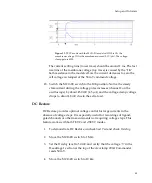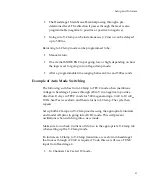
Guide
to
Electrophysiological
Recording
Optics
It
is
difficult
to
generalize
about
the
optical
requirements
of
the
chamber,
since
the
optical
technology
in
use
may
range
from
a
simple
dissection
scope
to
a
multiphoton
microscope.
In
general,
however,
it
is
probably
best
to
build
a
chamber
with
a
glass
microscope
coverslip
forming
the
bottom,
to
ensure
the
best
possible
optical
clarity.
Bath
Electrode
The
simplest
kind
of
bath
electrode
is
a
chlorided
silver
wire
placed
in
the
bath
solution.
However,
if
the
chloride
ion
concentration
of
the
bath
is
altered
by
perfusion
during
the
experiment,
this
kind
of
electrode
can
introduce
serious
voltage
offset
errors.
In
this
case
it
is
essential
to
use
a
salt
bridge
for
the
bath
electrode.
In
any
case,
at
the
end
of
every
experiment
it
is
good
practice
to
check
for
drift
in
electrode
offsets.
This
is
easily
done
by
pressing
the
I=0
button
on
the
Axoclamp
900A
Commander.
This
displays
on
the
meter
the
pipette
voltage
required
for
zero
current
through
the
electrode.
If,
for
instance,
the
meter
shows
2
mV,
there
has
been
a
2
mV
drift
since
the
electrodes
were
nulled
at
the
beginning
of
the
experiment,
and
your
voltage
values
may
be
in
error
by
at
least
this
amount.
Large
offset
errors
may
indicate
that
your
electrode
wires
need
rechloriding,
or
a
fluid
leak
has
developed
in
your
chamber,
causing
an
electrical
short
circuit
to
the
microscope.
If
you
use
both
headstages
on
the
Axoclamp
900A
(
e
.g.,
for
making
simultaneous
recordings
from
pairs
of
cells)
you
may
wonder
whether
one
or
both
headstage
ground
sockets
need
to
be
connected
to
the
bath
electrode.
We
have
found
empirically
that
the
noise
in
the
recordings
depends
on
which
headstage
is
grounded
and
what
mode
it
is
in
(V
‐
Clamp
or
I
‐
Clamp).
It
is
helpful
to
have
a
wire
connected
from
each
headstage
to
the
bath
electrode,
with
the
connection
able
to
be
switched
off
by
a
toggle
switch
without
bumping
the
electrode.
In
this
way
the
best
grounding
configuration
can
be
established
during
the
experiment.
61














































